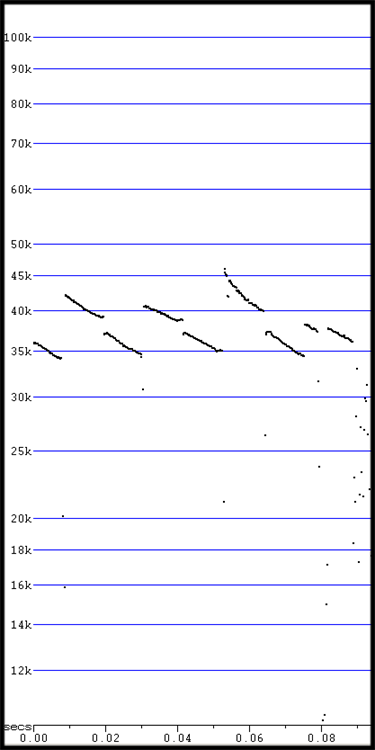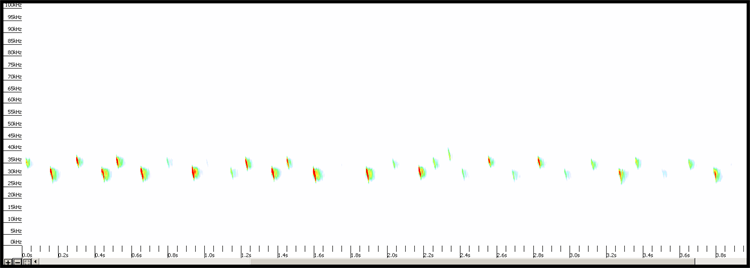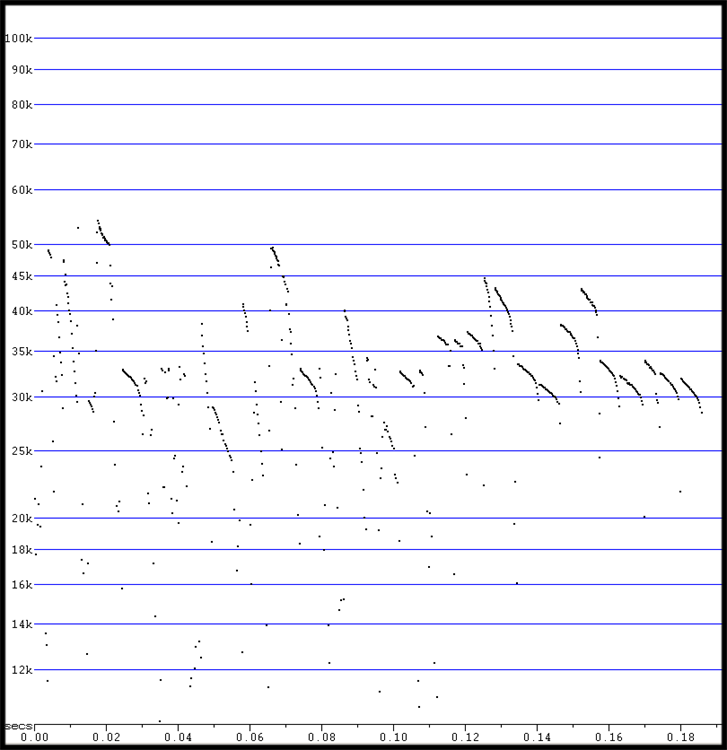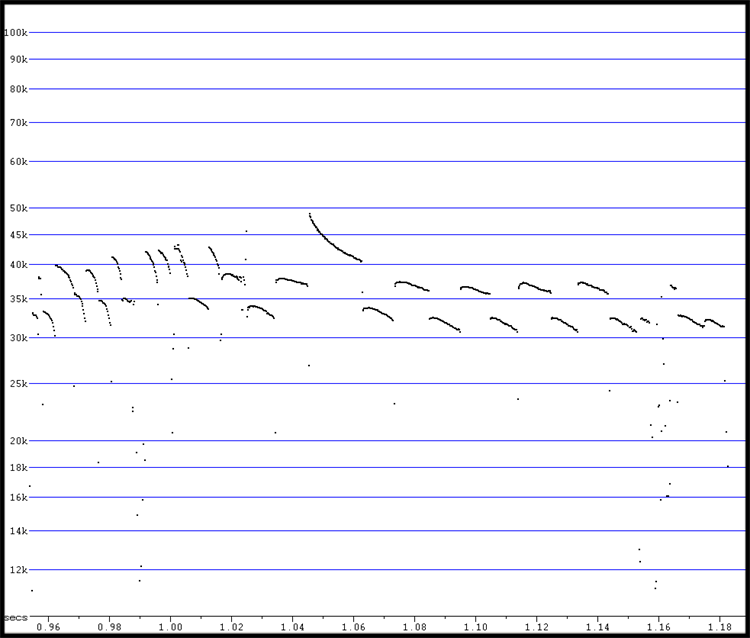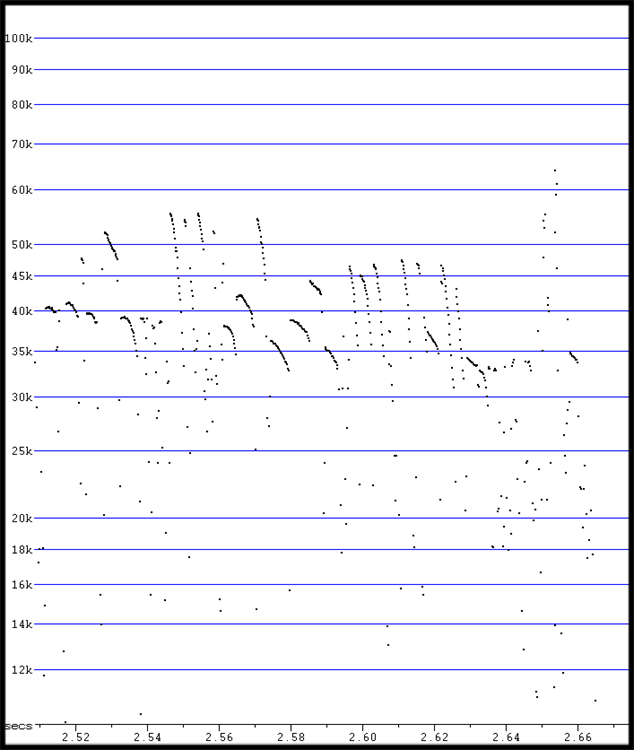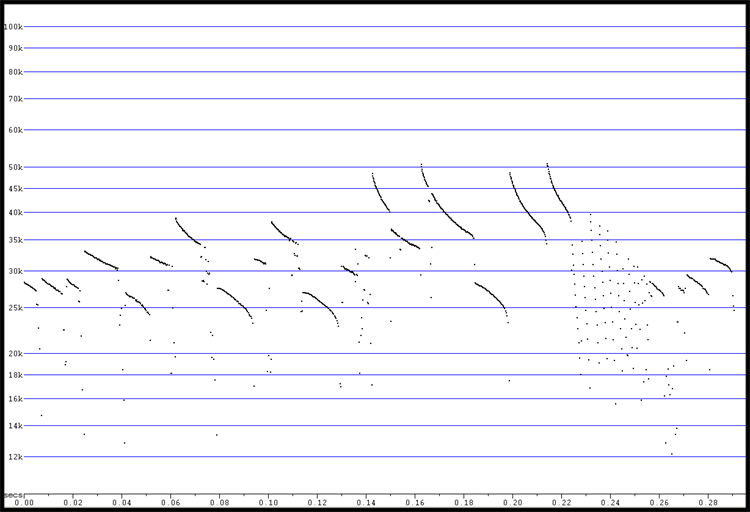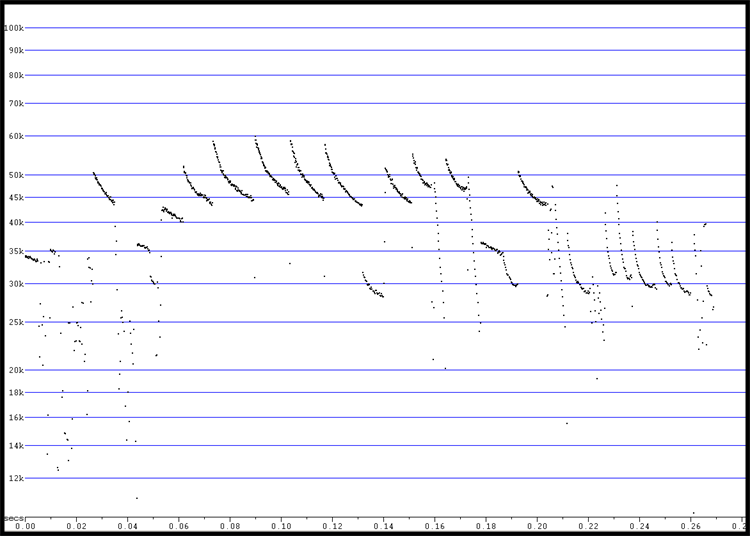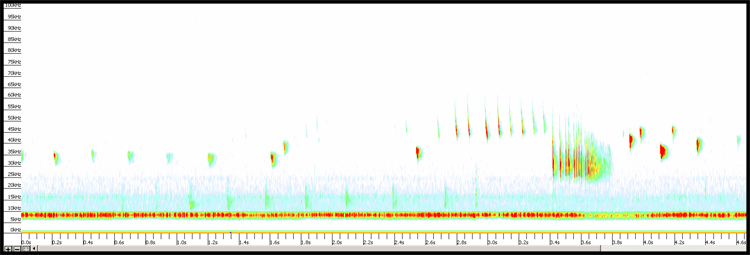Molossidae
Guide for Acoustic Identification of Florida bats
Molmil or Momi
See glossary for explanation of codes
Molossus milleri Johnson, 1952.
Taxonomy follows Simmons and Cirranello (2021). This species was previously assumed to be Pallas's Mastiff Bat (M. molossus). See Notes for further taxonomic details.
To view call graphics click on the camera icon on the right. You can then move through all images by using the left or right arrow keys. A left mouse click returns to the fact sheet.
A full range of call images are provided both as ZC and full spectrum.
Search phase calls are QCF paired high and low pulses both decreasing in frequency. Auto ID algorithms generally cannot correctly identify paired pulses and will flag clutter and feeding buzz pulses as Vespertilionids in error.
Depending on which part of a call sequence is first displayed, pulses are paired with a frequency shifts, The first pulse is followed by an identically shaped pulse at a lower frequency. See graphics.
Note that when recorded under clutter conditions e.g. at or near roosts, pulses may appear as triplets.
Approach phase calls and feeding buzzes are variable and shift to broad band pulses that are considerably higher in frequency and of shorter duration. Out of the context of complete call sequences these pulses may be mistaken for Vespertilionid calls.
Caution!!! AutoID algorithms will likely misclassify such pulses as species of a Vespertilionid..
Species of the genus Molossus use paired pulses. Search phase calls are an FM pulse at one frequency followed by another FM pulse at a lower frequency. Parameters for both upper and lower pulses are provided here.
| Upper pulses | |||||||||
| Parameters | N | Min | Max | Mean | St.Dev | 10% | 25% | 75% | 90% |
| Dur | 1604 | 5.00 | 19.96 | 8.07 | 2.63 | 5.43 | 6.10 | 9.09 | 11.44 |
| Fmin | 1604 | 35.01 | 43.36 | 37.97 | 1.71 | 35.87 | 36.70 | 39.02 | 40.40 |
| Fmax | 1604 | 36.61 | 44.94 | 41.02 | 1.98 | 38.46 | 39.41 | 42.55 | 43.84 |
| Fmean | 1604 | 36.07 | 44.41 | 39.55 | 1.64 | 37.52 | 38.32 | 40.68 | 41.95 |
| Fk | 1604 | 35.71 | 44.94 | 40.46 | 1.81 | 38.28 | 39.02 | 41.67 | 43.01 |
| Fc | 1604 | 36.04 | 43.96 | 38.69 | 1.69 | 36.61 | 37.30 | 39.83 | 41.03 |
| Sc | 1604 | -80.69 | 59.29 | 11.47 | 7.27 | 4.68 | 7.16 | 14.79 | 20.32 |
| Pmc | 1604 | 0.00 | 22.70 | 6.06 | 4.12 | 2.30 | 3.40 | 7.10 | 12.77 |
| Lower pulses | |||||||||
| Parameters | N | Min | Max | Mean | St.Dev | 10% | 25% | 75% | 90% |
| Dur | 1048 | 5.00 | 19.86 | 8.90 | 3.03 | 5.68 | 6.56 | 10.39 | 12.97 |
| Fmin | 1048 | 31.01 | 34.93 | 32.88 | 0.97 | 31.50 | 32.19 | 33.61 | 34.21 |
| Fmax | 1048 | 34.04 | 36.95 | 35.35 | 0.80 | 34.26 | 34.69 | 35.96 | 36.53 |
| Fmean | 1048 | 32.28 | 35.98 | 34.20 | 0.75 | 33.24 | 33.63 | 34.77 | 35.24 |
| Fk | 1048 | 34.04 | 36.95 | 35.18 | 0.78 | 34.19 | 34.48 | 35.79 | 36.28 |
| Fc | 1048 | 31.13 | 34.93 | 33.35 | 0.84 | 32.26 | 32.72 | 33.90 | 34.56 |
| Sc | 1048 | 0.00 | 43.68 | 11.53 | 4.26 | 7.29 | 8.75 | 13.52 | 16.76 |
| Pmc | 1048 | 0.70 | 16.60 | 6.03 | 2.20 | 3.60 | 4.50 | 7.23 | 9.20 |
Bruce W. Miller: recorded throughout South America, Mesoamerica and Cuba with data sets from several Caribbean islands provided by additional collaborators.
Cynthia Marks, George Marks: Florida Keys
Susie Nuttall (FWC): Florida Keys
Reference calls recorded by Marks and Miller are being archived at BioAcoustica and will be freely available. See Baker et al., (2015).
This species has one of the most limited distribution in the state and is restricted to southern Keys (Frank 1997).
This species has not yet been evaluated. However, if like the Florida Bonneted Bat (E. floridanus), this species is determined to be unique as M. tropidorhynchus it will be recognized as having a range more restricted than the Florida Bonneted Bat and be extremely vulnerable.
Loureiro, et al., (2018, 2019, 2020) for recent clarification of species limits within this complex genus.
There is a possibility that this species found in the Florida Keys may be a distinct species M. tropidorhynchus. Additional genetic work needs to be completed to verify whether this is the same species that occurs in Cuba or as was the case of; E. glaucinus that was found to be distinct as E. floridanus.
This will have important conservation implications if so. See Frank 1997 for discussion of possible origins of this species.
Acoustic parameters including complete acoustic repertoire for this genus are being summarized based on range wide distribution in a paper in preparation with José Ochoa (Miller and Ochoa, 2021). To date 60,000 calls have been measured for the genus Molossus from over 40 geographical locations including Caribbean Islands. >20,000 of verified as putative M. molossus.
Courtesy of FWC a significant acoustic Molmil data set has been provided from the lower Florida Keys.
See Baker et. al., (2015) for discussion of BioAcoustica and Baker and Vincent (2019) for a critique of the lack of freely available acoustic data.
Baker, E., B. W. Price, S. D. Rycroft, J. Hill, and V. S. Smith. 2015. BioAcoustica: a free and open repository and analysis platform for bioacoustics. Database. 2015. bav054
Baker, E., and S. Vincent. 2019. A deafening silence: a lack of data and reproducibility in published bioacoustics research? Biodiversity Data Journal 7: e36783.
Frank, P. A. 1997. First record of Molossus molossus tropidorhynchus Gray (1839) from the United States. Journal of Mammalogy. 78: 103-105.
Loureiro, L. O., R. Gregorin, and F. A. Perini. 2018. Diversity, morphological phylogeny, and distribution of bats of the genus Molossus E. Geoffroy, 1805 (Chiroptera, Molossidae) in Brazil. Zoosystema. 40: 425-452.
Loureiro, L. O., M. Engstrom, B. Lim, C. L. González, and J. Juste. 2019. Not All Molossus are Created Equal: Genetic Variation in the Mastiff Bat Reveals Diversity Masked by Conservative Morphology. Acta Chiropterologica. 21.
Loureiro, L. O., M. D. Engstrom, and B. K. Lim. 2020. Single nucleotide polymorphisms (SNPs) provide unprecedented resolution of species boundaries, phylogenetic relationships, and genetic diversity in the mastiff bats (Molossus). Mol. Phylogenet. Evol. 143: 106690.
Marks, C. S., and G. E. Marks. 2006. Bats of Florida. Pp. 176. University of Florida Press, Gainesville.
Miller, B. W., and J. Ochoa. 2021. Acoustic repertoire of the genus Molossus (Molossidae) in a range-wide sea of confusing calls. TBD. in preparation
Simmons, N. B., and A. L. Cirranello. 2020. Bat Species of the World: A taxonomic and geographic database. http://batnames.org
